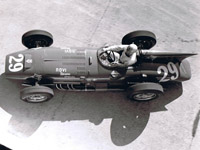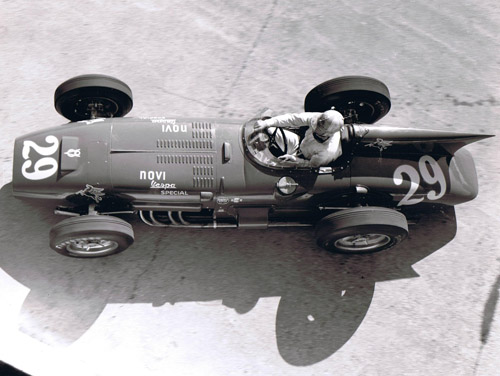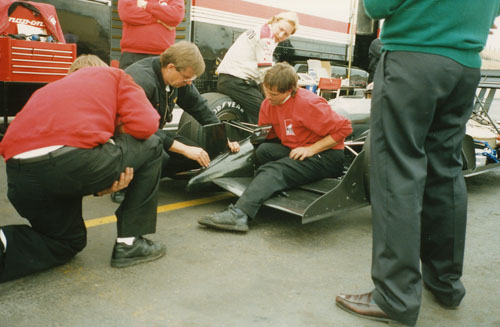Mercedosaurus Rex at Indianapolic Park
Part 11: The 1994 Indycar season until mid-April
Author
- Henri Greuter
Date
- December 4, 2009; unicorn fin picture added March 14, 2012
Related articles
- March-Alfa Romeo 90CA - Fiasco Italo-Brittanico, by Henri Greuter
- March-Porsche 90P - The last oddball at the Indianapolis Motor Speedway, by Henri Greuter
- Penske-Mercedes PC23-500I - Mercedosaurus Rex at Indianapolic Park, by Henri Greuter
- Introduction
- Part 1: Penske Racing at Indianapolis - new standards
- Part 2: Ilmor Engineering at Indianapolis
- Part 3: Mercedes, Benz and Mercedes-Benz at Indianapolis up until 1993
- Part 4: Equivalency formulas - waiting for things to go wrong
- Part 5: Stock blocks - keeping them rolling and promoting 'Born in the USA' technology
- Part 6: Indianapolis 1991 - Chevy And Rich Team owners
- Part 7: The Speedway narrowed, its speeds lowered
- Part 8: The forerunner
- Part 9: Pre-May '94 plans
- Part 10: Penske PC23 - a home for the engine
- Part 12: The unfair advantage and when others have it
- Part 13: Practice during the 1994 'Month of May'
- Part 14: Other bespoke-design 209s
- Part 15: From the last weekend of May '94 to the end of the season
- Part 16: Could the Mercedes Benz 500I have been stopped in time?
- Part 17: Creating an extinct species without it being forbidden, initially at least
- Part 18: The 1995 '500' - Did the Mercedosaurus bite its masters after all?
- Part 19: A possible twist of fate for Rahal-Hogan and Penske as a legacy of the 500I
- Part 20: Re-evaluation of our verdict
- Part 21: PC23's further active career after 1994
- Part 22: USAC’s points of views and some answers
- Part 23: The loose ends that didn’t fit in anywhere else and the epilogue
- Part 24: "Plan your work; work your plan" - Chuck Sprague on the PC23
- Appendix 1: Specifications
- Appendix 2: Car and driver appearances and performances during the Month of May 1994
- Appendix 3: Chassis, entry, practice and race numbers in 1994
- Appendix 4: PC23's 1994 results sans Mercedes Benz 500I
- Appendix 5: PC23's 1995-'96 results sans Mercedes Benz 500I
- Appendix 6: A reflection on the PC23 chassis used by Team Penske in 1994
- Appendix 7: A review of Beast by Jade Gurss
Who?Paul Russo What?Kurtis-Novi 500F Where?Indianapolis When?1956 Indianapolis 500 |
 |
Why?
The 1994 CART season started with a sensation. The brand new Reynard 94I CART chassis won its first ever race convincingly. The car was entered by Target Ganassi racing, powered by a Ford XB, and driven by Michael Andretti.
In the mean time, the first questions about what was going on at Penske Racing were raised. Penske had entered no less than eight cars for three drivers. But much to the surprise of the careful onlooker on the entry list, all five backup cars were not described in detail but merely as TBA/TBA. In short, the chassis type and engine type was not specified.
Rumours were going there was something going on at Team Penske. Nigel Beresford recalled how he was approached by well-known journalist Gordon Kirby who mentioned he had heard that Penske would have a pushrod at Indianapolis and how stupid it was to think such since they didn't understand what such a project would take. Nigel recalled how he merely nodded his head…
The Dean of American Motor Racing Journalists, the legendary Chris Economaki, was another journo fouled by a Penske team member: no less than Roger himself! In his biography Let ‘Em All Go! Chris described how at Phoenix 1994 he talked with Roger Penske about the rumours of Penske doing something different at Indianapolis and how Roger dodged the questions. But also, once the secrecy about the engine's existence was gone, how Roger came back to him to apologize for Phoenix and explaining why this had been.
Phoenix, the first oval race of the season (held on the 10th of April) showed the first signs of things to come that year. Team Penske scored a double victory with their PC23-Ilmor D, Emerson Fittipaldi winning ahead of Al Unser Jr. Third driver Paul Tracy crashed out in a race that became perhaps the best remembered for because of the crash in which Jacques Villeneuve ran into the car of Hiro Matsushita and literally drove through Hiro's car, separating engine and transmission from the monocoque.
A remarkable detail on the three Penskes was that they carried massive vertical fins on the engine covers, an aerodynamic tweak. But one with a history. In sportscar racing the Jaguar D-types had been famous for them, while at Indianapolis they had been used in the late fifties, the Novis being the most famous cars to employ them. The fins on the Penskes were referred to by several sources in the USA as the Novi fins.

This picture could easily have gone into the introduction chapter 'The forerunner', but isn't this a suitable location for it in order to show how the fins on the engine covers of the Penske got their nickname 'Novi fins'? This is Paul Russo in the brand new 1956 Kurtis 500F Novi, the only car-driver combination ever that scored a point in the World Championship in a race they finished dead last! Paul's fastest lap in the race however earned him the point and the curious World championship statistic. (photo courtesy IMS Photos, used with permission)
In the first tests with the finned cars, they had looked even more radical. They were initially fitted with a unicorn fin on the nose as well. However, the drivers had felt that this unsettled the car on entry to the turns and so it was abandoned and never seen in public.
When seen from aside, the unicorn fin was located on the detachable nose cone, but not over the entire length of the cone but at the end part, attached at the monocoque. When seen from aside, the unicorn fin was positioned about the same location as the front wings were on the superspeedway version of the PC23. As for size, it was about 20cm (approx. 8") long and high.

A picture of the “unicorn” fin, taken during one of the pre-season tests with the PC23 at Phoenix in either December ’93 or January ’94. Penske's chief designer Nigel Bennett shows Rick Rinaman (crew chief, Fittipaldi) how the fin should be fitted, as mechanic Kevin Chambers (in white), engineer Nigel Beresford (in green) and others watch with interest. (photo Nigel Beresford collection, used with permission)
Ilmor 265E breaks cover: 'Mercedosaurus Rex' let loose at 'Indianapolic Park'
Not a race date but an important date in the history of the 265E was April 6, 1994. On that day Mercedes Benz decided they would support the Ilmor 265E program if Penske Racing was to use the engine in all its three scheduled race cars at Indianapolis.
Another week later, the secrecy about the engine was lifted. During a press conference at the Indianapolis Motor Speedway Museum, Penske Racing and Mercedes Benz announced the existence of the pushrod engine they intended to use the upcoming month of May and that it was named Mercedes-Benz 500I.
Roger Penske told the attending media:
"In looking at the USAC rules for the 1994 Indianapolis 500 with Mercedes-Benz, we thought the push rod/two-valve design would be a competitive power plant, considering the past success of the Buick pushrod engine. With this commitment from Mercedes-Benz, we are addressing the challenge of developing this new engine for the 1994 Indianapolis 500."
Penske added the following about the preparations for the upcoming 500 miles event:
"We'll be running this car next week and the week after and throughout the month of May to try to get the durability we need to finish the race. It's one thing to say you've got a new formula and a new engine, but we have to finish the race, I don't come to Indianapolis counting on dropping out at 100 laps. I've been there. I know what it feels like. So it's important for everyone to know that this engine has to have the durability. We understand that and there are some risks associated with this type of engine versus a full racing type engine. I think everyone will acknowledge that."
Helmut Werner, President and Chief Executive Officer of Mercedes-Benz AG, commented:
"We think that together with Penske and Ilmor, we have an unique opportunity to go to Indianapolis in 1994 with three champion drivers: Emerson Fittipaldi, Paul Tracy, and Al Unser, Jr. Indianapolis is the world's largest single day sporting event. The Indianapolis 500 presents a substantial challenge for a manufacturer to demonstrate technical excellence. But most importantly, Mercedes-Benz want to support its U.S. market offensive by its participation in this most important motor race."
Mario Illien, designer of the new Mercedes-Benz Indy engine, had the following to say:
"The engine ran for the first time in late January, so of course, there are risks associated with the short time frame for development In addition, it is most important to have a car and transmission designed to utilize the pushrod/two-valve engine. We are working closely with Marlboro Team Penske on a track testing program to develop durability. These elements of risk are essential to the development of a new engine, especially for the world's most important race."
The attending press members were permitted to ask questions and Roger Penske was asked if the reported power advantage of some 100hp over the conventional racing engine was close to accurate. Penske gave the following, very diplomatic answer:
"I would say, I knew I was going to get that question, so I have an answer. I said we hope we'll be competitive by race day. Really, I think that people that talk about horsepower on all engines, we talked about the Indy race engines, the overhead camshaft versions. There have been all sorts of horsepower talked about, the Ilmor and also the Ford. At this time, we do not have a power level that we're going to announce, because we don't know what it's going to take to be reliable at this point."
As for announcing the existence of the engine and the intention to use it, the timing was perfect. It was too late for anybody else to obtain something similar, or having built something similar to counteract. And it was also too late for USAC to change the rules all of a sudden. If something was done that was against this engine, no doubt that it would generate a lot of bad publicity for USAC and the Speedway management at a moment they couldn't use any bad publicity. Besides that, the project made quite an impact with the majority of the racing fans and caused heaps of attention. Thus acting against it was likely not a very good idea.
The outcry about the mere existence of the engine was tremendous. Many competitors instantly accepted defeat to a car that was to have at least 150hp more then they had.
There was a lot of criticism from several corners but Penske defended the engine with the explanation that the rules had been there for some time and everybody else could have done the same. One of the most outspoken people was defending CART champion Nigel Mansell. His reaction was:
"What a brainless idea that is (to allow Penske such an advantage). I mean, how the hell can you give them 10 inches more turbo boost. That guarantees them 150 to 200 horsepower more."
The PC23 scored its second Ilmor/D-motivated victory when Al Unser Jr. won the prestigious Long Beach event on April 17.
At that time, chassis PC23-004 had been used as the designated test car for the 500I engine. But now, four of the five other existing cars were rebuilt and fitted with the 500I. And a new car, chassis 007 was added to the batch of cars.
As for the testing done up till that time, I found the following data in a media bulletin dated April 20, 1994.
The engine was said to have run 2,500 miles in testing. Its longest sustained run to date had been 470 miles. The best lap to date at MIS has been just over 225mph with a maximum straightline speed of 237mph. Mario Andretti took the pole at MIS last year at 234.275mph. At Nazareth, the best lap so far was 19.90s, not quite as fast as the best lap recorded with a standard Penske-Ilmor combination.
The press bulletin didn't list what had been the fastest time for a standard Penske-Ilmor. But as for what speeds were possible at Nazareth, the following can be told.
Qualifying had rained out during the 1993 running of the Nazareth event. The fastest lap speed recorded in practice had been 19.749s. I haven't found any data about speeds that a PC23-Ilmor 265D may have achieved during tests in the built up to the CART championship, thus in early 1994. At the end of the season, when the Nazareth race took place, Emerson Fittipaldi took pole with a lap time of 19.397s. Both these were times set on a rubbered-in track, in qualifying conditions.
It also needs to be pointed out that during the Nazareth test runs, when Paul Tracy did the 19.90s lap, he was under the instructions to drive reasonably fast instead of “flat-out” in order to put miles on the engine. And he drove on a green track in cold conditions. Given all these circumstances, a fastest lap of 19.90s is pretty good.
With Long Beach done, the team could concentrate entirely on Indianapolis. And despite all the work done already, it remained necessary according Paul Tracy who is quoted to have said:
"The reliability is not there yet. That's the key thing. Another key thing is that all the guys in the team were as unaware of this program as everyone else until a few weeks ago. Only the five guys working on the project knew about it so that everyone has to learn how to make motor changes and how to work on the new gearbox."
As for what was literally to be the strong point of the engine, Paul said:
"I don't know what the horsepower numbers are. But it definitely has some horsepower."
Paul also foresaw that the engine wouldn't be easy to drive at Indianapolis.
"It'll be a new experience. Compared to the normal Ilmor, it has a low rev limit and narrow power band. We'll have to be really careful leaving the pits to make sure not to spin the tires too much or overrev the engine."
In the second half of April and early May Paul and this team mate Al Unser Jr. were kept busy with sorting out their wonder weapon. Emerson Fittipaldi, the third member of the team had not been involved with this development work.
Until it was time for the Month of May, “back home again in Indiana”.
